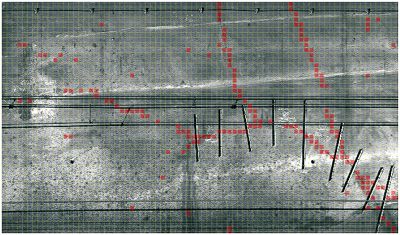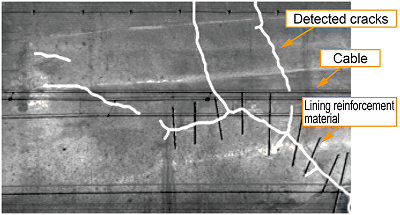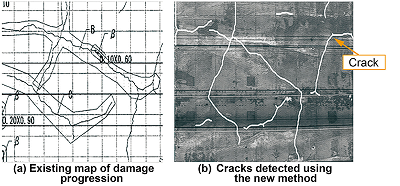11. Tunnel lining crack detection method using deep learning or multi-layer neural network
Existing image processing programs to detect structural damage such as cracks required the fine-tuning of numerous parameters and experience-based expertise. Furthermore, with existing systems any change in picture being processed requires time-consuming readjustment of parameters. Another drawback with current image processing is the difficulty in removing any similar looking features, or noise, from the image, such as cables or masonry joints.
A method introducing a ‘learning’ based image analysis technology has been developed therefore, to distinguish cracks from images applying a deep learning process (multi-layer neural network). Two classifiers were created after learning from a large volume of pictures in two groups - either “presence of a crack” or “absence of a crack”. When these classifiers or sorters were presented with a new picture, they recognised the presence or absence of a crack with over 90% successful detection (Fig. 1, Fig. 2). A hybrid detection method was proposed using a color-coded pixelated picture to show the position of probable cracks and which is then analysed focusing on location and direction of the crack. Fig. 3 shows that the level of crack detection using this method is close to that of a human being, making it possible to generate an automatic maps showing damage progression.
This method could be used for other purposes such as detection of leaking water, etc. therefore the next step is to make this system commercially available.
Other Contents
- 10. Design method for concrete filled tube members with rectangular section
- 11. Tunnel lining crack detection method using deep learning or multi-layer neural network
- 12. Methods to detect and predict rapid localized deterioration of track irregularity
- 13. Development of new solid-bed track with resilient sleepers using shear-key to achieve efficient construction work
- 14. Profiling (through grinding) of aging rails based on X-ray diffraction analyses
- 15. Improving OCL connector fatigue resistance
- 16. Proposal for light weight high-rigidity car body structure
- 17. Reduction in manufacturing cost of C/C composite pantograph contact strips and clarification of their wear limit
- 18. Method for evaluating serviceable life and deterioration of electronic interlocking equipment
- 10. Design method for concrete filled tube members with rectangular section
- 11. Tunnel lining crack detection method using deep learning or multi-layer neural network
- 12. Methods to detect and predict rapid localized deterioration of track irregularity
- 13. Development of new solid-bed track with resilient sleepers using shear-key to achieve efficient construction work
- 14. Profiling (through grinding) of aging rails based on X-ray diffraction analyses
- 15. Improving OCL connector fatigue resistance
- 16. Proposal for light weight high-rigidity car body structure
- 17. Reduction in manufacturing cost of C/C composite pantograph contact strips and clarification of their wear limit
- 18. Method for evaluating serviceable life and deterioration of electronic interlocking equipment



